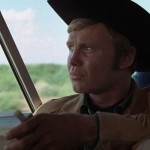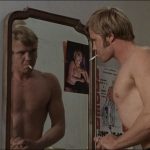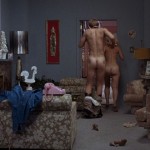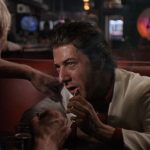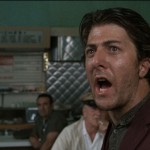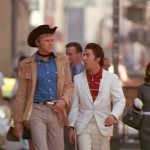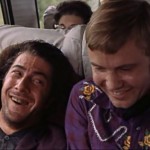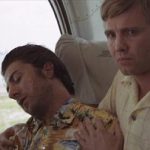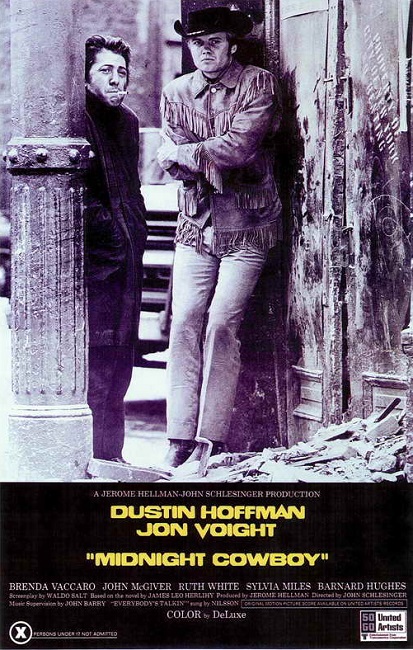
Midnight Cowboy – 1969
This was a strange movie. Several people had told me how it was such a great and depressing movie, and it certainly had its depressing elements. But I think that maybe I had so prepared myself to watch a super depressing film, that when the tragedy occurred, I just wasn’t as moved as I should have been.
It is interesting to note that this is the only X-rated movie to ever win Best Picture. The rating was not due to the film’s sexual content (though there were plenty of bare breasts being shown during the intense sex scenes), but its homosexual content. You see, the plot was about a young man from Texas who packs up and goes to New York to become a male prostitute. John Voight plays Joe Buck, our handsome young hustler. The problem, though, is that he isn’t too bright. He quickly runs through all of his cash and becomes homeless.
Having come from Texas, Joe has a self-image that combines John Wayne and Gene Autry. He always dressed in his costume, consisting of black cowboy boots, tight pants, flashy rodeo style shirts, a western jacket with lots of fringe, and a big Stetson cowboy hat. He got a special kick out of looking at himself in the mirror. But whenever anyone asked him if he was really a cowboy, he said, “Well, I’m not really a cowboy, but I’m one hell of a stud.” At several points, to earn money he had to have sex with men. Executives at United Artist consulted with a psychologist, and were told that the film’s homosexual content could have a possible influence upon youngsters. Thus we have an X-rated movie.
A crippled con man and petty thief named Enrico “Ratzo” Rizzo, played by Dustin Hoffman, swindles Joe out of some money. Then later on, in penance, he invites Joe to stay with him in a condemned building. The two become “business partners” and then friends. As winter arrives, Joe’s career as a prostitute finally starts to take off, while Ratzo’s health fails.
But there is a fairly extensive back story for Joe that is told in flashbacks. Director John Schlesinger used a strange but effective way of showing those flashbacks. A quick series of broken, random images are thrown up on to the screen. Some of them are in focus while others are not. Some of the images show bits of action and others show still shots. Some were shown in black and white while others were in color. Those barrages of stream-of-consciousness images were only shown when the character was reflecting, dreaming, day-dreaming, or high on hallucinogens.
However, these sequences were remarkably effective, showing how Joe and his girlfriend, Crazy Annie, were found having sex. They were ostracized by the community, and later gang raped by a group of men. Even Joe was sodomized by the culprits. Afterword, Annie was sent to an asylum while Joe joined the Army. We also learn more of Joe’s earlier childhood, how his mother abandoned him and his inattentive grandmother raised him. Ratzo’s little bit of back story is told in simple exposition when he talks to Joe.
Both Hoffman and Voight did a good job in this film. Though I have never been a big fan of either actor, I must admit that Voight pulled off pretty and stupid quite convincingly. Hoffman did a good job as the con-man, however, I have seen the 1988 Best Picture winner, Rain Man, and at times, I felt like I was watching the same character; except for the little scene where that famous line from the film is spoken. “I’m walkin’ here! I’m walkin’ here!”
Interesting note: Most of the people to whom I have spoken about the movie, claim that the line was completely improvised and off-script. However, producer Jerome Hellman claims that the cab driver was a paid actor and the line was, in fact, scripted.
Another interesting part of the film is the depiction of the Warhol-esque party to which Joe is invited. The bright colors, the acid-trip music, and the strange people, all combine to make a very groovy sixties scene. It very clearly places the movie in that era. I would even go so far as to say that it is a veritable snapshot of that time in history.
The film had a very gritty and real feel to it. I think it really captured the squalor of being homeless in New York in the winter. The dirt and grime on the streets, the broken down and dilapidated condemned building in which the characters lived, the seedy under-belly of the counter-culture which they only touched the edge of, all came together to make a very realistic depiction.
And finally, one of the things that I really liked about the film was the ending. I understand that the end of the movie is what causes everyone to say that it was a depressing movie. But I felt that it was an appropriate ending for a number of reasons.
First, Ratzo’s death was inevitable. They started showing that he was getting sick pretty early on in the film so it didn’t come as a surprise when it happened. As a small time con man and petty thief, he would naturally have an aversion to going to the police or the hospital for any reason. So, when Joe tells him that he is going to get a doctor, it was within his character to refuse.
Second, by the end of the story, Joe had finally started to grow up. He had given up his dreams of being a street hustler. But the real tragedy of the plot was that it was too little, too late. You see, it is clear that the only reason the two friends stayed in New York as long as they did was so that Joe could continue hustling. It wasn’t until it became evident that Ratzo was dying, that Joe realized that his friendship with him was more important than his questionable career, and they headed for Florida. But by then it was too late. If they had gone earlier, there may have been time for his health to improve.
In essence, don’t get thrown off by the X-rating. This was definitely a drama. In retrospect, I think it might even be categorized as a coming-of-age drama. Joe grows from being a naïve boy from Texas with skewed dreams of self-gratification and success, to a man who has known friendship and loss. It is very telling that as he finally makes this transition, he buys new clothes that are more befitting a man who is not trying to live out a fantasy, and throws away the cowboy costume, boots and all.
The movie only won three academy awards: Best Picture, Best Director (Schlesinger), and Best Adapted Screenplay. Both Hoffman and Voight were nominated for Best Actor, though neither of them took home the Oscar.
Interesting note: Sylvia Miles played the role of Cass, a hooker that actually ends up taking money from Joe when he is trying to hustle her. Though she only had about five minutes of screen time, she was nominated for Best Supporting Actress, one of the shortest performances ever to be nominated for the category.
